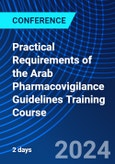On 1 July 2015, the Common Arab Guidelines on good vigilance practices became effective. The Guidelines represented fundamental changes to pharmacovigilance practice and followed many aspects of the EU guidelines of June 2012.
This intensive two-day course will look at the various topics and their practical application from the perspective of compliance with the requirements of the Regulatory Authorities. The course will include experiences of the inspections and audits following implementation and will identify what the main focus points have been for possible inspection findings.
This interactive course will help you:
- Gain an overview of the modules and the responsbilities of the Marketing Authorisation Holder (MAH)
- Discuss the practical application of the modules and documentation required
- Discover the levels of implementing Quality Management Systems (QMS) throughout the company
- Understand the regulatory expectations of inspections
- Realise what written processes need to be in place
Certification:
- CPD: 12 hours for your records
- Certificate of completion
Agenda
Day 1
An introduction to the PV structure
- Overview of the modules
- The interaction of the modules
- A comparison to the EU modules
Module I - Quality Management Systems (QMS)
- Quality control, quality assurance, and quality management
- Quality management of PV systems
- The QPPV and quality management
- Quality and training
- QA and quality management and internal audits
Module II - the pharmacovigilance system master file (PSMF)
- The content of the PSMF
- License submissions and the PSMF
- The QPPV and the PSMF
- Control/management of the PSMF
Module III - pharmacovigilance inspections
- The purpose of the inspection
- Types of inspection
- Inspection findings
- Re-inspections
Module IV - pharmacovigilance audits
- The purpose of company audits
- Audit scheduling and risk
- Audit outputs and findings
- Audit findings and their corrections - root cause analysis, corrective action plans, completion and re-audits
Day 2
Module V - risk management plans (RMPs) and risk minimisation
- ICH E2E - pharmacovigilance planning
- The RMP purpose
- The RMP format
- Updating the RMP
- RMPs and risk evaluation & mitigation strategies (REMs)
Module VI - adverse reaction reporting (part 1)
- Definitions
- Special situations
- Triage - seriousness
- Expectedness and causality
- Expedited reporting
Module VI - Adverse Reaction Reporting (part 2)
- Electronic ADR reporting - local and international
- Follow-up of cases
- ICH E2D - post-marketing safety
- Literature ADR reporting
- Case closure
Module VII - periodic safety update reports (PSURs)
- ICH E2F and ICH E2C (R2) - development safety update reports (DSURs) and PSURs/periodic benefit-risk evaluation reports (PBRERs)
- Objectives of the PSURs
- Risk benefit analyses in PSURs
- The format of the PSUR
- Mapping signals and risks to the PSUR
Module IX - signals and their management and safety communication
- What is a signal?
- Signal validation
- Signal analysis and prioritisation
- Signal assessment
- Actions to be taken - safety communication
Module VI - adverse reaction reporting (part 1)
- Definitions
- Special situations
- Triage - seriousness
- Expectedness and causality
- Expedited reporting
Module VI - Adverse Reaction Reporting (part 2)
- Electronic ADR reporting - local and international
- Follow-up of cases
- ICH E2D - post-marketing safety
- Literature ADR reporting
- Case closure
Module VII - periodic safety update reports (PSURs)
- ICH E2F and ICH E2C (R2) - development safety update reports (DSURs) and PSURs/perdiodic benefit-risk evaluation reports (PBRERs)
- Objectives of the PSURs
- Risk benefit analyses in PSURs
- The format of the PSUR
- Mapping signals and risks to the PSUR
Module IX - signals and their management and safety communication
- What is a signal?
- Signal validation
- Signal analysis and prioritisation
- Signal assessment
- Actions to be taken - safety communication
Speakers

Mr Graeme Ladds,
Director ,
PharSafer Associates Ltd.Graeme Ladds, Director of PharSafer, has over 22 years’ experience working in the pharmaceutical industry. Having started his career at Ashbourne Pharmaceuticals in 1989 as Head of Drug Safety & Medical Information, Graeme went on to become Head of Global Pharmacovigilance at Shire Pharmaceuticals.
The last 11 years have been spent in his consultancy company, PharSafer Associates Ltd. During this time, Graeme has been involved in establishing pharmacovigilance in companies, performing audits across Europe and the USA, SOP writing, acting as QP for companies, and helping with regulatory inspections.
Who Should Attend
Anyone involved in pharmacovigilance and regulatory activities in the Middle East/Arab States - including pharmacovigilance case processing, local QPPVs, medical directors, drug safety managers, QA auditing, PSUR writers, and any company managers and licence holders wanting to know what impact this will have on their business practices.
This course will also be beneficial to companies looking to expand into this geographic area.









